How to use Management Analytics
Management Analytics equips managers with interactive reports and analysis to help them make data-based decisions to drive sales and improve KPIs.
Management Analytics provides insights into key metrics and gives managers the data they need to decide how to move forward. The interactive reports compare sales YOY (year over year) and invoices to target, revealing trends and changes in booked and invoiced orders. Along with displaying KPIs, like total sales and average margins per sales rep and client account, Management Analytics gives managers a detailed overview of their sales team's CRM, shops, and sales activity.
Management Analytics will help answer questions like:
- How much has my team booked this month?
- What is our monthly revenue?
- Have we reached our sales target?
- Who are our most profitable clients?
- What are our most profitable shops?
- What has my sales team been up to
This help article explains how to use Management Analytics to track trends, make more profitable business decisions, and drive your sales team to work with the right clients.
Users need permission to "View Management Menu" to use Management Analytics.
This feature is not available to teams subscribed to commonsku's Essentials plan. The Advanced plan or higher is required in order to use this tool.
On this page:
How to sort Management Analytics by rep, client, or client status
Key terms
Booked order: A project that has a sales order and purchase orders. A sales order is "booked" when the client approves the sale, and the rep creates supplier POs.
Client rep: The salesperson who manages the client's account, usually known as the account manager or account executive.
Client status: Customizable fields that help organize your customer portfolio for more detailed reporting.
In production: A project that has a sales order and purchase orders. A sales order's status automatically changes to In Production when a rep creates the supplier purchase orders.
Margin/Profit: Sales revenue minus the cost of goods sold, not including tax. Margins can be displayed as a whole number or a percentage.
Pre-sale: A preliminary sales form, like a presentation or estimate, or any sales-related activity before creating an actual sales order, like a new sales opportunity.
Revenue: Total sales income, not including tax.
Value: An estimate, sales order, or invoice's subtotal.
KPIs: Key performance indicators.
Edit Targets
Users with permission to modify sales targets and view the management menu can set their team’s sales targets through the Management Analytics tab.
To set a target:
- Click the Edit Targets button
- Use the radios to select whether to set targets against invoices, sales orders in production, or both
- Click the rep drop-down menu and select the rep
- Click the year drop-down menu and select the year
- Enter/change the targets
- Click Close

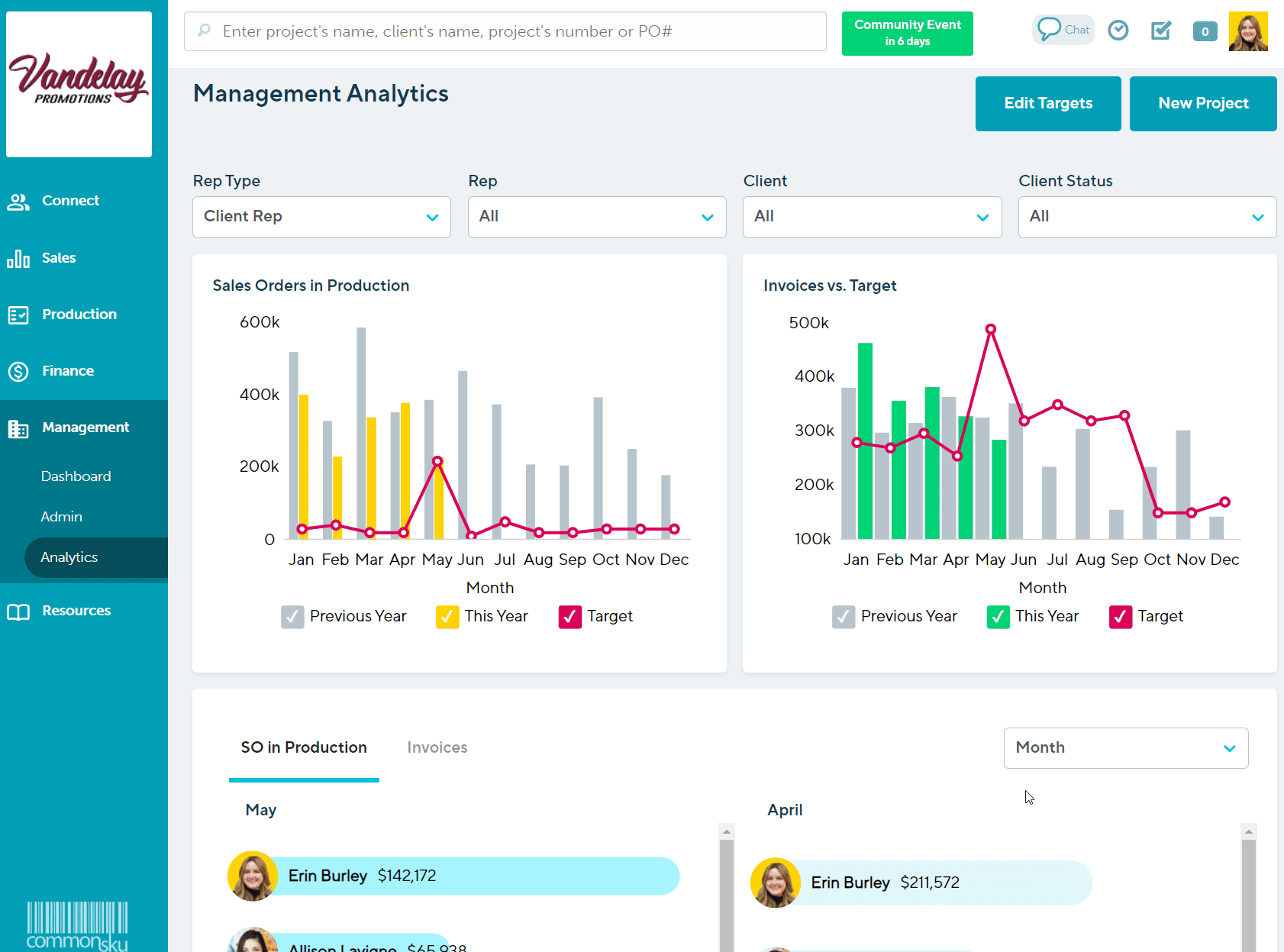
How to create a new project from your Management Analytics
- Click New Project in the top right corner.
- Select a pre-existing client from the drop-down list, or click + New Client at the bottom of the drop-down to add a new client to commonsku
- If you are adding a new client (optional):
- Type the client's name
- Select their industry from the drop-down menu
- Click Create Client
- If you are adding a new client (optional):
- Enter a Project Name
- Select an Event Type from the drop-down
- Select your Starting Stage
- Click Continue

How to sort Management Analytics by rep, client, or client status
Management Analytics can display metrics for an entire sales team, a particular rep, a group, a specific client, or clients with a certain status.
Managers can alternate the Management Analytics' filters as needed to track trends across different reps and clients.
Sales Orders in Production
Sales Orders in Production tracks booked orders month-over-month and year-over-year.
Managers can monitor orders in production to confirm sales are moving down the pipeline and see how production has increased or decreased compared to the same time last year, and either track an entire team's sales target or an individual rep's.
The Sales Orders in Production Reports’ pop-up menu reveals which orders were booked within a given month, providing insight into big wins and potential gaps in anticipated vs. booked sales.
How to use Sales Orders in Production:
- Hover over a month to see the value of sales orders in production and compare how numbers have increased or decreased compared to last year, and track how their sales are doing to target.
- Click into a month to open a list of sales orders in production for that month
- Filter the sales orders by selecting different column titles (for example, click on the "Stage" column to filter the results by stage)
- Click on the hyperlinked project name or number to be redirected to the project
- Select any project to open a slide-out menu with more details and action items, like completed or pending action items (tasks). From the slide-out menu, you can:
- Update the form's status, the project's in-hands date, budget, and assigned reps
- Create and manage any related tasks
- Click the Actions button to view either the project or the client's page.
- Deselect the checkbox beside "Previous Year", "This Year", or "Target" to remove it from the graph and click the zoom-out icon to increase the value range.

commonsku Tip: The Work in Progress Report gives further insight on In Production. Managers or finance reps can filter orders to reveal orders awaiting invoicing, the value of invoices, and the cost of goods sold.
Invoices vs. Target
Invoices vs. Target measures how monthly revenue compares to the sales teams' targets.
Managers can use Invoices vs. Target to track revenue and their team's progress towards either tracking their entire team's sales target or an individual rep's.
The Invoices vs. Target Reports' popup menu shows which invoices were created within a given month, including their invoice status, enabling reps to catch any missed orders and keep track of invoices that need to be sent to the client, exported, or are pending payment.
How to use Invoices vs. Target:
- Hover over a month to see the value of invoices created within that month and compare sales to target.
- Click into a month to open a list of invoices within that month
- Filter the invoices by selecting different column titles (for example, click on the "Stage" column to filter the results by stage)
- Click on the hyperlinked project name or number to be redirected to the project
- Select any project to open a slide-out menu with more details and action items, like completed or pending action items (tasks). From the slide-out menu, you can:
- Update the form's status, the project's in-hands date, budget, and assigned reps
- Create and manage any related tasks
- Click the Actions button to view either the project or the client's page.
- Deselect the checkbox beside "Previous Year", "This Year", or "Target" to remove it from the graph and click the zoom-out icon to increase the value range.
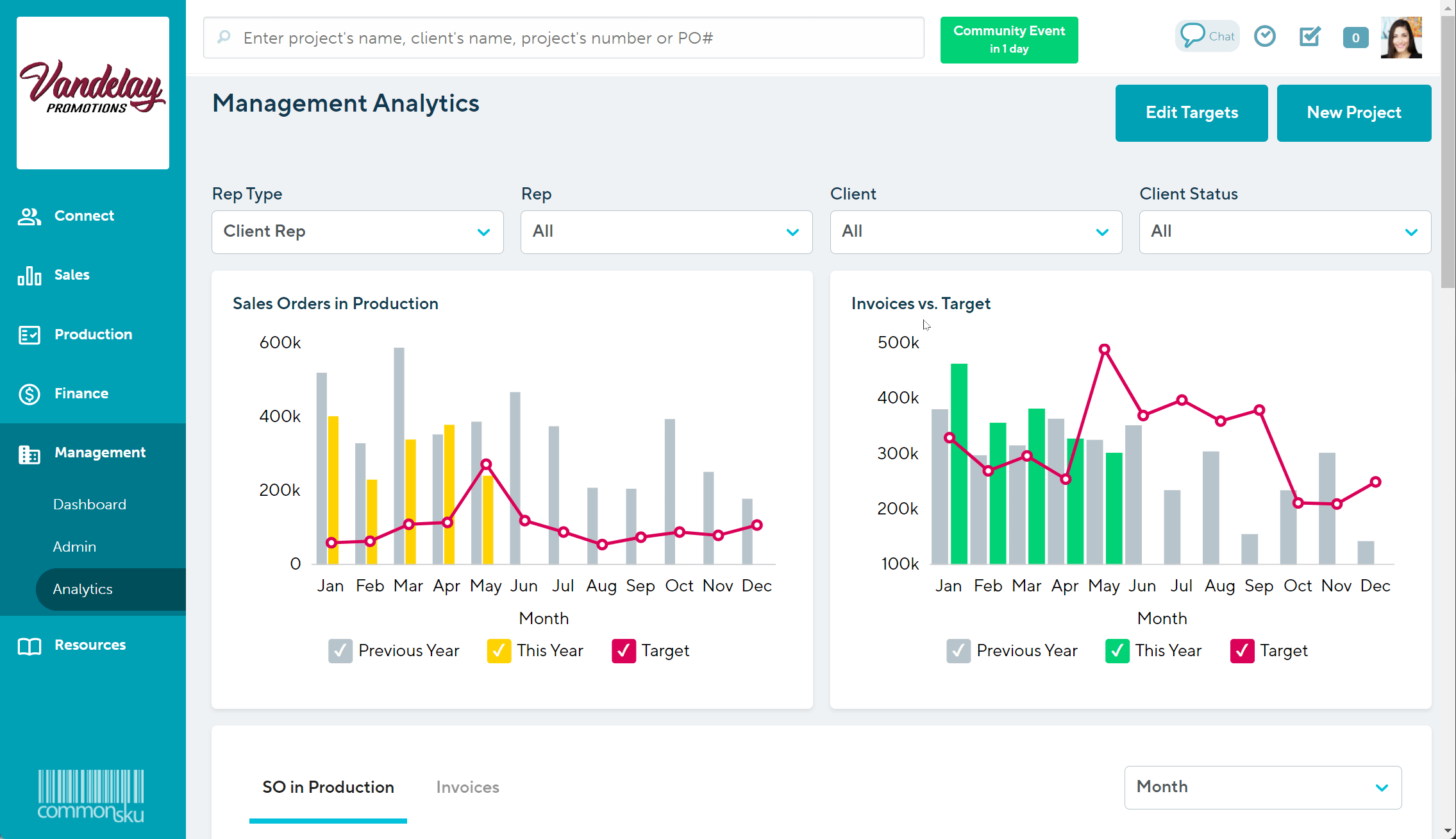
Users with permission to "modify sales target" can set monthly sales goals through the Sales tab > Projects > Sales Forecast Report.
SO in Production Report
Sales Orders in Production Report tracks booked orders month-over-month and year-over-year. This report will answer questions like:
- Who are my top performers?
- Where are there opportunities for coaching?
- How are my reps doing this week/month/year compared to last week/month/year?
How to use the SO in Production Report:
- Click on a rep to open a list of sales orders in production for that month
- Filter the sales orders by selecting different column titles (for example, click on the "Stage" column to filter the results by stage)
- Click on the hyperlinked project name or number to be redirected to the project
- Select any project to open a slide-out menu with more details and action items, like completed or pending action items (tasks). From the slide-out menu, you can:
- Update the form's status, the project's in-hands date, budget, and assigned reps
- Create and manage any related tasks
- Click the Actions button to view either the project or the client's page.
- Select the date filter in the top right corner to view the top reps by week, month, or year
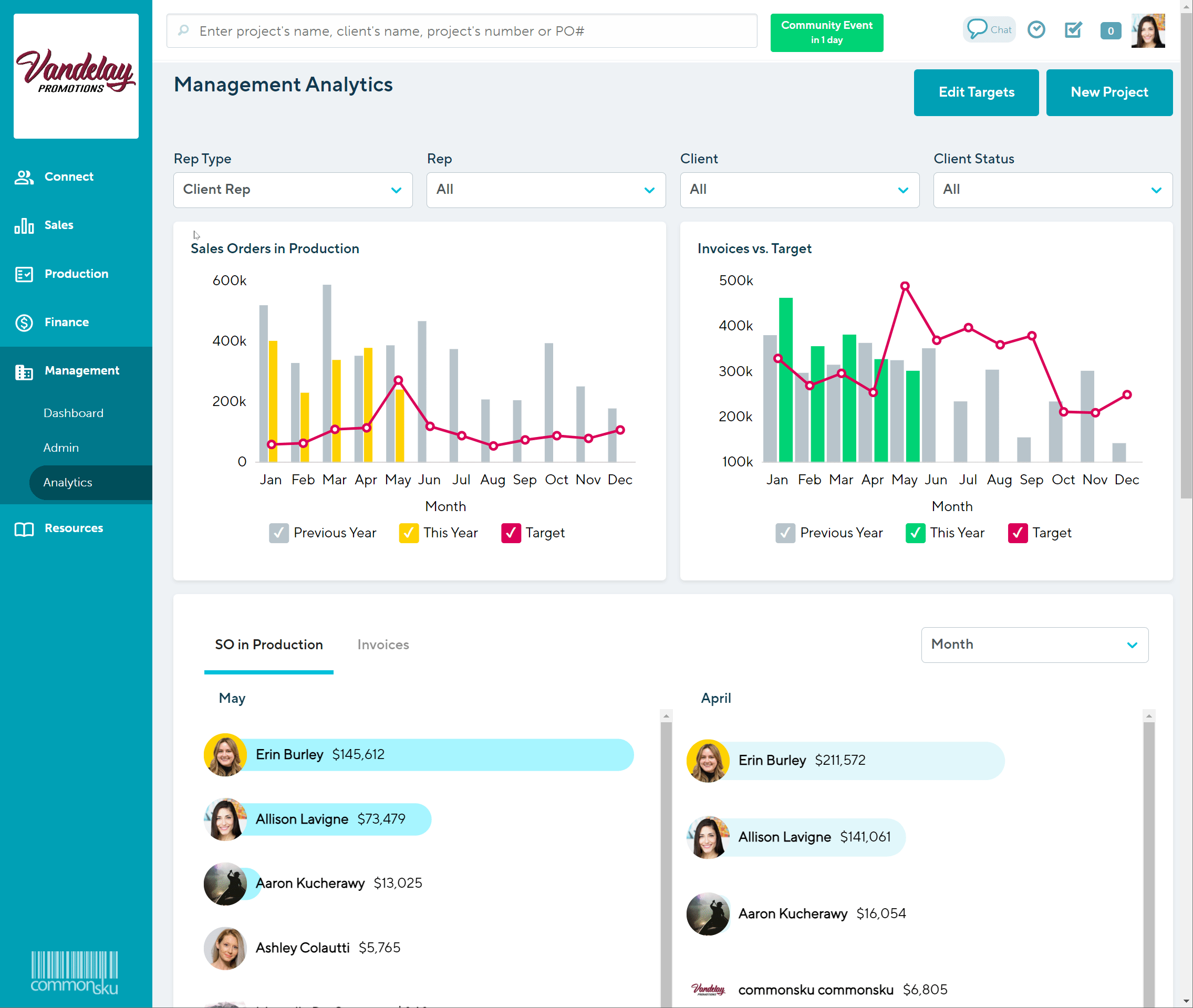
Invoices Report
The Invoices Report tracks invoices month-over-month and year-over-year. This report will answer questions like:
- Who are my top performers?
- Where are there opportunities for coaching?
- How are my reps doing this week/month/year compared to last week/month/year?
How to use the Invoices report
- Click on a rep to open a list of invoices for that month
- Filter the invoices by selecting different column titles (for example, click on the "Stage" column to filter the results by stage)
- Click on the hyperlinked project name or number to be redirected to the project
- Select any project to open a slide-out menu with more details and action items, like completed or pending action items (tasks). From the slide-out menu, you can:
- Update the form's status, the project's in-hands date, budget, and assigned reps
- Create and manage any related tasks
- Click the Actions button to view either the project or the client's page
- Select the date filter in the top right corner to view the top reps by week, month, or year

Sales by Client
Sales by Client measures sales from this month and last month by revenue earned per client. Isolating sales per client reveals the highest-selling accounts as a percentage of total sales and shows how they drive company earnings.
Managers can use Sales by Client to identify their sales reps' top accounts and coach them to work with the right clients.
How to use Sales by Client:
- Hover over the doughnut chart's slices (yum) to view the dollar value of sales per client.
- Click into a client-specific section to open a list of invoices
- Filter the invoices by selecting different column titles (for example, click on the "Stage" column to filter the results by stage)
- Click on the hyperlinked project name or number to be redirected to the project
- Select any project to open a slide-out menu with more details and action items, like completed or pending action items (tasks). From the slide-out menu, you can:
- Update the form's status, the project's in-hands date, budget, and assigned reps
- Create and manage any related tasks
- Click the Actions button to view either the project or the client's page.
- Select the "Other" slice to view clients that make up the lower portion of total sales. Click the zoom-out icon to return to the standard view.
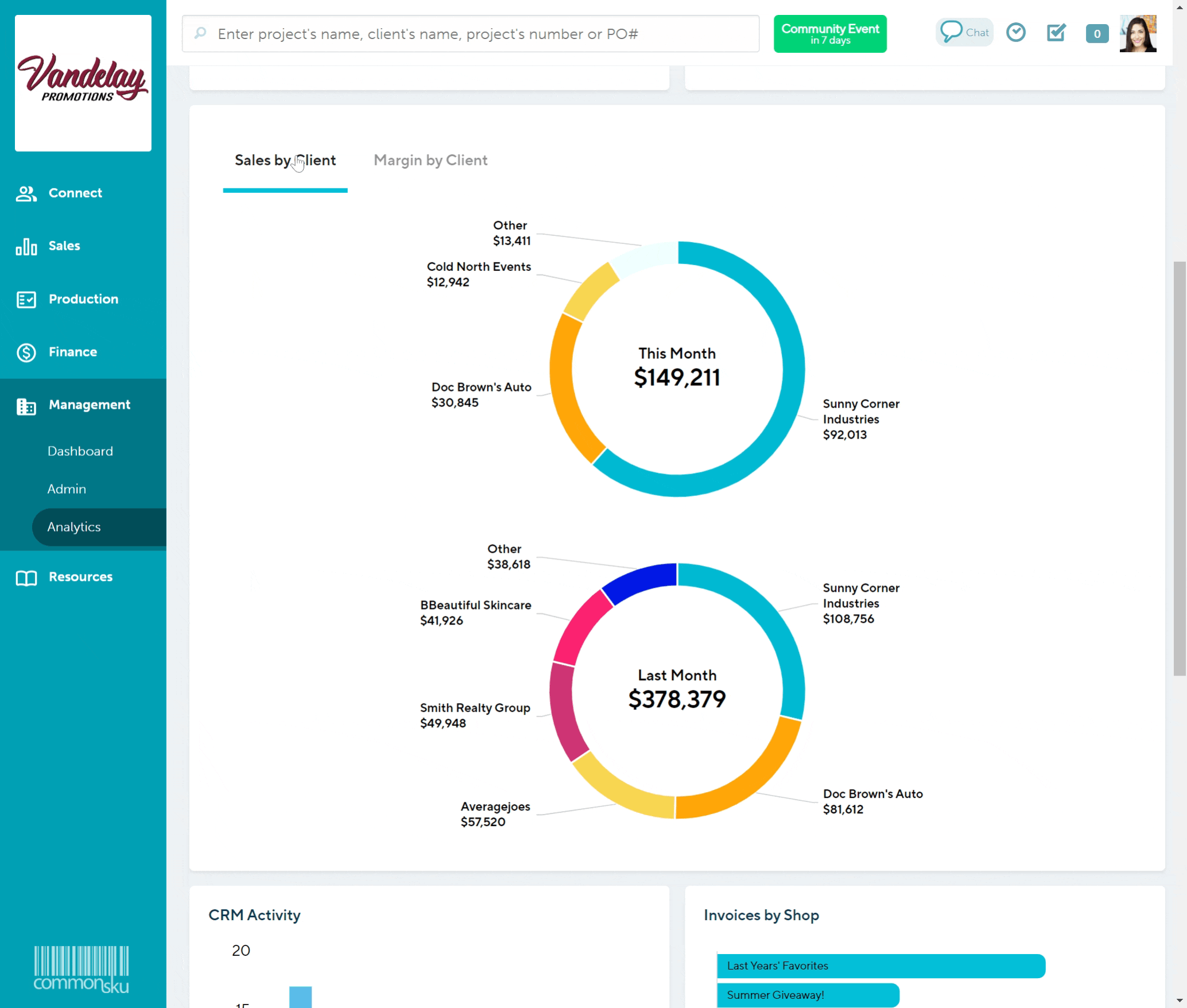
Margin by Client
Margin by Client measures margins from this month and last month by profit earned per client. Isolating margin per client reveals the most profitable accounts as a percentage of the total margin.
Managers can use Margin by Client to identify their sales reps' highest margin accounts and help coach them to increase their average margin.
How to use Margin by Client:
- Hover over the doughnut chart's slices (yum) to view profit per client.
- Click into a client-specific section to open a list of forms
- Filter the forms by selecting different column titles (for example, click on the "Stage" column to filter the results by stage)
- Click on the hyperlinked project name or number to be redirected to the project
- Select any project to open a slide-out menu with more details and action items, like completed or pending action items (tasks). From the slide-out menu, you can:
- Update the form's status, the project's in-hands date, budget, and assigned reps
- Create and manage any related tasks
- Click the Actions button to view either the project or the client's page.
- Select the "Other" slice to view clients that make up the lower margin sales. Click the zoom-out icon to return to the standard view.
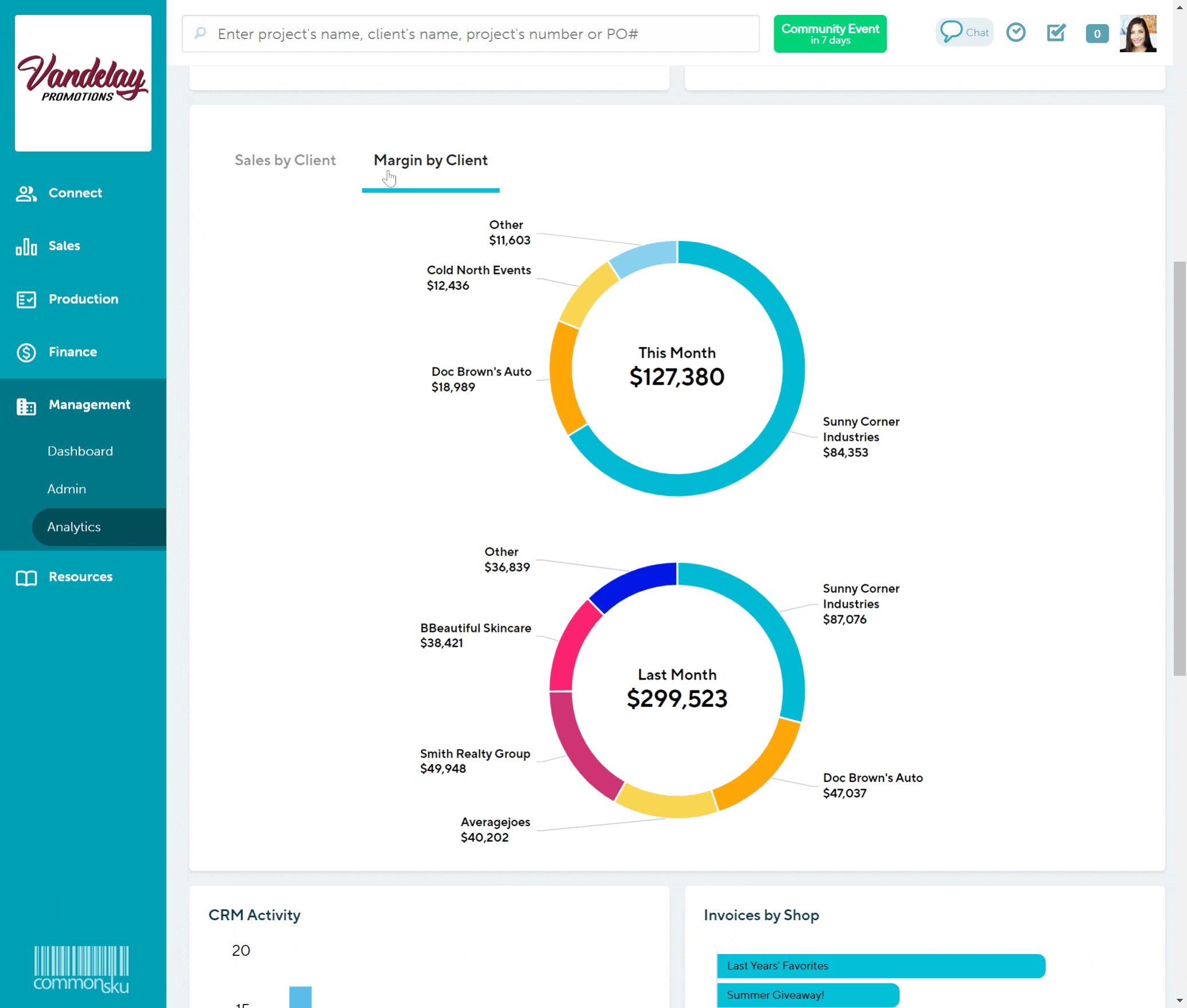
CRM Activity
CRM Activity tracks how many notes, meetings, and calls reps have logged on their client/contact pages.
CRM Activity is an invaluable coaching tool because it helps managers understand what their sales reps are working on outside their pre-sales and sales orders.
How to use CRM Activity:
- Hover over a month to see the total count of notes, meetings, and calls logged within the month.
- Deselect the checkbox beside "Notes," "Meetings," or "Calls" to remove it from the graph and click the zoom-out icon to increase the value range.
Sales Activity
Sales Activity counts the number of pre-sale forms created within a month.
Pre-sales activity is an indicator of potential sales. Managers can watch pre-sales in real-time to track their sales teams' potential orders and monitor conversion rates.
The Sales Activity Reports' pop-up menu displays pre-sale forms created within a given month along with their current status, encouraging reps to grow their totals, convert their pre-sales to orders, and review cancellations.
How to use Sales Activity:
- Hover over a month to see the total count of estimates, presentations, and opportunities created within the month.
- Click into a month to open a list of sales orders in production for that month
- Filter the sales orders by selecting different column titles (for example, click on the "Stage" column to filter the results by stage)
- Click on the hyperlinked project name or number to be redirected to the project
- Select any project to open a slide-out menu with more details and action items, like completed or pending action items (tasks). From the slide-out menu, you can:
- Update the form's status, the project's in-hands date, budget, and assigned reps
- Create and manage any related tasks
- Click the Actions button to view either the project or the client's page.
- Deselect the checkbox beside "Estimates," "Presentations," or "Opportunities" to remove it from the graph and click the zoom-out icon to increase the value range.
commonsku Tip: Use the Sales Rep Report to identify conversion rates by comparing Converted pre-sales to Closed pre-sales.
Invoices by Shop
Invoices by Shop tracks the top ten highest-grossing commonsku Shops based on orders created over the last sixty days.
Invoices by Shop makes it easy for managers to monitor the success of their shops, stay in the loop with their sales teams' top-earning shops, and track the profitability of shops per client.
FAQ
Are the Management Analytics reports based on booked margins or billed margins?
Analytics reports are based on each project's billed margin.